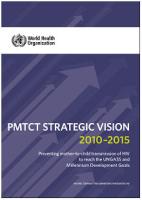
Feature Story
New WHO strategy calls for elimination of HIV in children by 2015
21 апреля 2010
21 апреля 2010 21 апреля 2010
Preventing mother-to-child transmission of HIV (PMTCT) is one of the key pillars in the worldwide response to the AIDS epidemic and one of the priorities of UNAIDS Secretariat and its Cosponsors. The World Health Organization (WHO) has recently published a strategy paper outlining its commitment to support country-level and global efforts to scale up PMTCT services and to integrate such services into maternal, newborn and child health programmes.
Preventing mothers from dying and babies from becoming infected with HIV is one of UNAIDS’ key priority areas as outlined in its . The new PMTCT strategic vision 2010–2015: preventing mother-to child transmission of HIV to reach the UNGASS and Millennium Development Goals, reflects an important part of WHO’s health sector response to HIV and will contribute directly towards achieving the results of the Outcome Framework.
As a UNAIDS cosponsor which co-leads efforts to prevent mother-to-child HIV transmission within the United Nations, along with cosponsor UNICEF, WHO will use the PMTCT strategic vision to accelerate global support for prevention of mother-to-child HIV transmission.
The strategy paper urges the international community to set new, more ambitious targets that promote progress towards the virtual elimination of paediatric HIV by 2015. It also calls for greater collaboration with partners, such as the Global Fund to fight AIDS, Tuberculosis and Malaria, and the US President’s Emergency Plan for AIDS Relief (PEPFAR).
Significant progress in PMTCT has occurred in recent years and in 2008 around 45% of pregnant women living with HIV in low- and middle-income countries received antiretroviral drugs to prevent mother-to-child transmission of HIV. This is in contrast to only 10% in 2004.
Despite these successes, coverage levels of PMTCT services are still low in a number of resource-limited countries and communities. According to the UNAIDS/WHO AIDS Epidemic Update 2009 an estimated 430,000 children were newly infected with the virus in 2008, more than 90% of them through vertical transmission from their mothers. Without treatment, around half of these children will die before their second birthday.
But mother-to-child transmission is almost entirely preventable where services are accessible, and PMTCT interventions can reduce the risk of infection to less than 5%.
The PMTCT strategic vision can help address this by promoting a comprehensive approach that includes the following four components: primary prevention of HIV infection among women of childbearing age; preventing unintended pregnancies among women living with HIV; preventing transmission from an HIV-positive woman to her infant; and providing appropriate treatment, care and support to mothers living with HIV and their children and families.
The new document highlights a series of needed strategic directions:
- Strengthen commitment and leadership to achieve full coverage of PMTCT services
- Provide technical guidance to optimize HIV services for women and children
- Promote and support integration of HIV interventions within maternal, newborn and child health and reproductive health programmes
- Ensure equitable access for all women, including the most vulnerable
- Support health systems interventions to improve service delivery
- Track programme performance and impact
- Strengthen global, regional and country partnerships and advocate for increased resources.
The publication provides a number of country and regional examples. In Asia, several nations have begun linking HIV services with reproductive, adolescent, maternal, newborn and child health services.
Along the same lines, the elimination of mother-to-child transmission of HIV and congenital syphilis in Latin America and the Caribbean (affecting some 6,000 children and 450, 000 pregnancies each year respectively) has been defined as a top priority by the WHO Regional Office for the Americas and UNICEF. Together with partners, they have recently launched a campaign with the objective to eliminate mother-to-child transmission of HIV by 2015.
The PMTCT strategic vision also shows that interventions needed vary depending on country or regional circumstances. In Eastern Europe, for instance, emphasis is not on general population interventions but on improving PMTCT services for key populations at higher risk such as injecting drug users and their partners.
It is clear that whatever the context, the need to eliminate mother-to-child transmission of HIV is of paramount necessity. The PMTCT strategic vision is designed to be a key tool to strengthen WHO's support to this global effort to save lives and protect the health of the world’s women and children.
New WHO strategy calls for elimination of HIV in
Cosponsors:
Feature stories:
UNAIDS and Private sector meet to explore collaboration towards virtual elimination of mother-to-child transmission (16 March 2010)
Global Fund projects that UNAIDS’ call for elimination of mother–to-child HIV transmission by 2015 is within reach (08 March 2010)
Data shows progress needed on HIV testing and treatment for children and mothers (30 November 2009)
Partnering with faith based organizations for virtual elimination of mother to child transmission of HIV (14 October 2009)
More infants protected from HIV as access to antiretroviral drugs to prevent mother-to-child transmission increases (30 September 2009)
Early diagnosis and treatment save babies from AIDS-related death (27 May 2009)
Publications:
Related
 United for ending cervical cancer, HIV and inequities for women and girls
United for ending cervical cancer, HIV and inequities for women and girls

17 ноября 2022 года.
 Delays in global, affordable access to long-acting, injectable HIV medicines would cost lives, say AIDS campaigners
Delays in global, affordable access to long-acting, injectable HIV medicines would cost lives, say AIDS campaigners

16 ноября 2022 года.
 Key considerations to integrate HIV and mental health interventions
Key considerations to integrate HIV and mental health interventions

28 апреля 2022 года.
